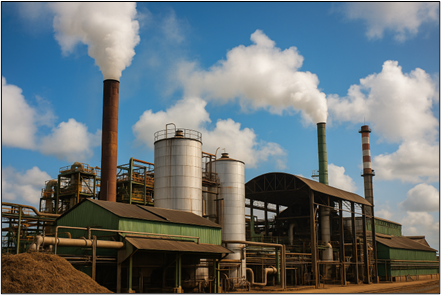Forecasting Failures: Smart Maintenance of Falling Film Evaporators in the Sugar Manufacturing Industry

Introduction
In the modern sugar manufacturing landscape, falling film evaporators (FFE) play a critical role in the multi-effect evaporation (MEE) system, where water is removed from sugar juice to concentrate it into syrup. These evaporators, while efficient, are susceptible to a gradual decline in performance due to fouling and scale buildup. As the overall heat transfer coefficient (HTC) drops, energy efficiency decreases, and operational bottlenecks increase, eventually resulting in unscheduled shutdowns and higher maintenance costs.
Predictive maintenance offers a compelling solution by forecasting when maintenance should be carried out; ideally, before a failure occurs, but not so early that resources are wasted. In this article, we explore how industrial data and first-principles understanding can be fused with machine learning (ML) to build a predictive model for estimating the remaining useful life (RUL) of falling film evaporators, with a focus on minimizing downtime in sugar factories.
Why Maintenance Matters in Falling Film Evaporators
Falling film evaporators are particularly vulnerable to fouling due to the nature of sugar juice, which contains suspended solids, colloidal materials, and microbial components. Over time, these contaminants form insulating layers inside the evaporator tubes, reducing the rate of heat transfer. As HTC drops, more steam is required to achieve the same concentration, increasing energy consumption and lowering throughput.
If fouling is left unchecked, it leads to severe inefficiencies, product quality degradation, and forced shutdowns that disrupt the overall production schedule. Maintenance, therefore, becomes not just a necessity but a strategic operation.
But traditional maintenance is often reactive or scheduled in fixed intervals; either too late, causing avoidable downtime, or too early, wasting resources. Predictive maintenance shifts this paradigm, enabling intervention just in time.
Modelling Remaining Useful Life (RUL) of Falling Film Evaporators
Predicting the Remaining Useful Life (RUL) of falling film evaporators is fundamentally a regression problem. The idea is to model the degradation of the heat transfer coefficient (HTC) over time and estimate how many days remain before the HTC drops below a critical threshold. This threshold (baseline HTC) is typically defined as 20% of the design HTC, representing the point at which performance is severely impaired.

Fig1. Predictive Maintenance of Evaporators
- Heat transfer coefficient (HTC)
- Inlet and outlet temperatures (hot and cold streams)
- Flow rates of both streams
- Operating pressure and steam temperature
- Fouling indicators (pressure drop, differential temp, etc.)
- Operating hours since last maintenance
- Temperature Delta (ΔT) = T_hot_in - T_cold_out
- Log Mean Temperature Difference (LMTD)
- Thermal Resistance = 1 / HTC
- Cumulative run-time since last maintenance
- Rate of change of HTC (ΔHTC/Δt) over sliding windows
- Gradient Boosting Regressors (e.g., XGBoost, LightGBM): Capture non-linearity and interactions between features.
- Random Forest Regressor: Robust to noise, avoids overfitting with high-dimensional features.
- Recurrent Neural Networks (RNNs)/LSTMs: Useful if HTC degradation shows temporal patterns that simpler models miss.
Conclusion: From Prediction to Prevention

Fig2. Approach for RUL prediction
Predicting RUL for falling film evaporators in sugar factories is not just a technical exercise; it’s an operational advantage. When maintenance windows can be forecasted with accuracy, plants can prepare spare parts, schedule labour, and minimize production loss. Moreover, data-driven insights foster a culture of continuous improvement.
By combining first-principle knowledge of heat exchangers with modern ML techniques, we enable proactive strategies that shift maintenance from a cost centre to a performance enabler. And the value is clear: reduced downtime, better resource utilization, and sustained product quality.
Domain-Wise PlantGPT
It is built around purpose-designed micro-agents that collaborate to provide real-time conversational assistance, decision support, and advisory insights tailored to daily plant operations.
Book a Demo →Dx. Consulting Services
Our strength lies in the fusion of deep consulting experience, process domain expertise, and digital execution excellence. This rare combination enables us to go beyond traditional digital transformation.
Book a Meeting →Agentic AI Services
Knowledge Graph as a Service (KGaaS) is a scalable, agent-driven platform that transforms siloed, unstructured, and structured industrial data into a semantically connected, intelligent knowledge network. Built on industry standards and ontologies, the platform enables next-gen applications in root cause analysis, process optimization, SOP automation, and decision augmentation.
Book a Meeting →FAQs
What is the heat transfer coefficient (HTC), and why is it important?
HTC measures the efficiency of heat transfer between two fluids. In evaporators, a lower HTC means reduced performance and increased energy use.
What causes fouling in sugar evaporators?
Fouling results from the deposition of insoluble substances like calcium salts, silica, organic matter, or microbial growth in the tubes of the evaporator.
How is RUL different from condition-based monitoring?
Condition-based monitoring flags problems when they arise, but RUL estimation forecasts how long the equipment can continue to operate safely.
What’s the benefit of predicting failure 20 days in advance?
It gives maintenance teams adequate time to prepare for cleaning, order parts, and schedule the intervention with minimal disruption.
How accurate are ML models for RUL prediction?
Accuracy depends on data quality, volume, and how well features are engineered. With well-maintained historical data, error margins can be within 5-10%.

%20(1).jpg)